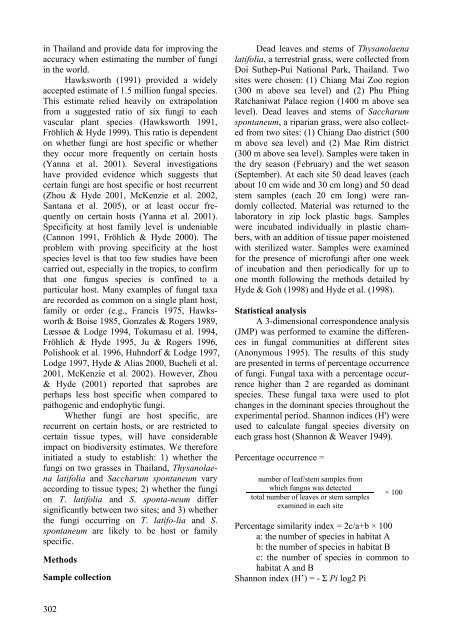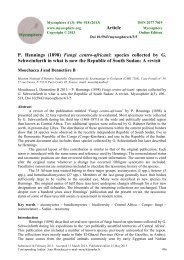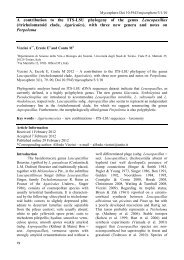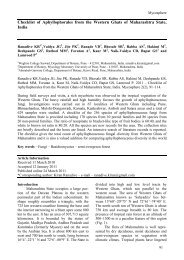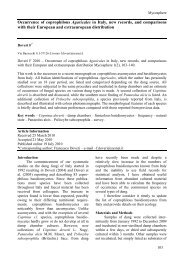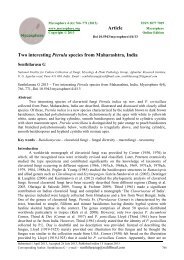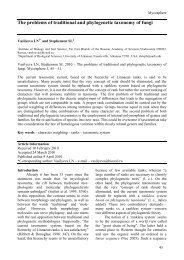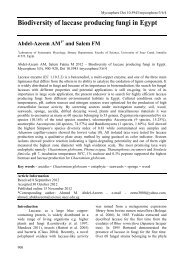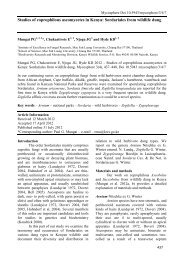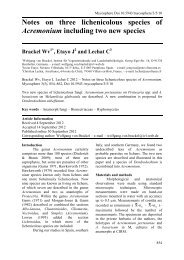Fungi on the grasses, Thysanolaena latifolia and Saccharum ...
Fungi on the grasses, Thysanolaena latifolia and Saccharum ...
Fungi on the grasses, Thysanolaena latifolia and Saccharum ...
Create successful ePaper yourself
Turn your PDF publications into a flip-book with our unique Google optimized e-Paper software.
in Thail<strong>and</strong> <strong>and</strong> provide data for improving <strong>the</strong><br />
accuracy when estimating <strong>the</strong> number of fungi<br />
in <strong>the</strong> world.<br />
Hawksworth (1991) provided a widely<br />
accepted estimate of 1.5 milli<strong>on</strong> fungal species.<br />
This estimate relied heavily <strong>on</strong> extrapolati<strong>on</strong><br />
from a suggested ratio of six fungi to each<br />
vascular plant species (Hawksworth 1991,<br />
Fröhlich & Hyde 1999). This ratio is dependent<br />
<strong>on</strong> whe<strong>the</strong>r fungi are host specific or whe<strong>the</strong>r<br />
<strong>the</strong>y occur more frequently <strong>on</strong> certain hosts<br />
(Yanna et al. 2001). Several investigati<strong>on</strong>s<br />
have provided evidence which suggests that<br />
certain fungi are host specific or host recurrent<br />
(Zhou & Hyde 2001, McKenzie et al. 2002,<br />
Santana et al. 2005), or at least occur frequently<br />
<strong>on</strong> certain hosts (Yanna et al. 2001).<br />
Specificity at host family level is undeniable<br />
(Cann<strong>on</strong> 1991, Fröhlich & Hyde 2000). The<br />
problem with proving specificity at <strong>the</strong> host<br />
species level is that too few studies have been<br />
carried out, especially in <strong>the</strong> tropics, to c<strong>on</strong>firm<br />
that <strong>on</strong>e fungus species is c<strong>on</strong>fined to a<br />
particular host. Many examples of fungal taxa<br />
are recorded as comm<strong>on</strong> <strong>on</strong> a single plant host,<br />
family or order (e.g., Francis 1975, Hawksworth<br />
& Boise 1985, G<strong>on</strong>zales & Rogers 1989,<br />
Læssøe & Lodge 1994, Tokumasu et al. 1994,<br />
Fröhlich & Hyde 1995, Ju & Rogers 1996,<br />
Polishook et al. 1996, Huhndorf & Lodge 1997,<br />
Lodge 1997, Hyde & Alias 2000, Bucheli et al.<br />
2001, McKenzie et al. 2002). However, Zhou<br />
& Hyde (2001) reported that saprobes are<br />
perhaps less host specific when compared to<br />
pathogenic <strong>and</strong> endophytic fungi.<br />
Whe<strong>the</strong>r fungi are host specific, are<br />
recurrent <strong>on</strong> certain hosts, or are restricted to<br />
certain tissue types, will have c<strong>on</strong>siderable<br />
impact <strong>on</strong> biodiversity estimates. We <strong>the</strong>refore<br />
initiated a study to establish: 1) whe<strong>the</strong>r <strong>the</strong><br />
fungi <strong>on</strong> two <strong>grasses</strong> in Thail<strong>and</strong>, <strong>Thysanolaena</strong><br />
<strong>latifolia</strong> <strong>and</strong> <strong>Saccharum</strong> sp<strong>on</strong>taneum vary<br />
according to tissue types; 2) whe<strong>the</strong>r <strong>the</strong> fungi<br />
<strong>on</strong> T. <strong>latifolia</strong> <strong>and</strong> S. sp<strong>on</strong>ta-neum differ<br />
significantly between two sites; <strong>and</strong> 3) whe<strong>the</strong>r<br />
<strong>the</strong> fungi occurring <strong>on</strong> T. latifo-lia <strong>and</strong> S.<br />
sp<strong>on</strong>taneum are likely to be host or family<br />
specific.<br />
Methods<br />
Sample collecti<strong>on</strong><br />
Dead leaves <strong>and</strong> stems of <strong>Thysanolaena</strong><br />
<strong>latifolia</strong>, a terrestrial grass, were collected from<br />
Doi Su<strong>the</strong>p-Pui Nati<strong>on</strong>al Park, Thail<strong>and</strong>. Two<br />
sites were chosen: (1) Chiang Mai Zoo regi<strong>on</strong><br />
(300 m above sea level) <strong>and</strong> (2) Phu Phing<br />
Ratchaniwat Palace regi<strong>on</strong> (1400 m above sea<br />
level). Dead leaves <strong>and</strong> stems of <strong>Saccharum</strong><br />
sp<strong>on</strong>taneum, a riparian grass, were also collected<br />
from two sites: (1) Chiang Dao district (500<br />
m above sea level) <strong>and</strong> (2) Mae Rim district<br />
(300 m above sea level). Samples were taken in<br />
<strong>the</strong> dry seas<strong>on</strong> (February) <strong>and</strong> <strong>the</strong> wet seas<strong>on</strong><br />
(September). At each site 50 dead leaves (each<br />
about 10 cm wide <strong>and</strong> 30 cm l<strong>on</strong>g) <strong>and</strong> 50 dead<br />
stem samples (each 20 cm l<strong>on</strong>g) were r<strong>and</strong>omly<br />
collected. Material was returned to <strong>the</strong><br />
laboratory in zip lock plastic bags. Samples<br />
were incubated individually in plastic chambers,<br />
with an additi<strong>on</strong> of tissue paper moistened<br />
with sterilized water. Samples were examined<br />
for <strong>the</strong> presence of microfungi after <strong>on</strong>e week<br />
of incubati<strong>on</strong> <strong>and</strong> <strong>the</strong>n periodically for up to<br />
<strong>on</strong>e m<strong>on</strong>th following <strong>the</strong> methods detailed by<br />
Hyde & Goh (1998) <strong>and</strong> Hyde et al. (1998).<br />
Statistical analysis<br />
A 3-dimensi<strong>on</strong>al corresp<strong>on</strong>dence analysis<br />
(JMP) was performed to examine <strong>the</strong> differences<br />
in fungal communities at different sites<br />
(An<strong>on</strong>ymous 1995). The results of this study<br />
are presented in terms of percentage occurrence<br />
of fungi. Fungal taxa with a percentage occurrence<br />
higher than 2 are regarded as dominant<br />
species. These fungal taxa were used to plot<br />
changes in <strong>the</strong> dominant species throughout <strong>the</strong><br />
experimental period. Shann<strong>on</strong> indices (H') were<br />
used to calculate fungal species diversity <strong>on</strong><br />
each grass host (Shann<strong>on</strong> & Weaver 1949).<br />
Percentage occurrence =<br />
number of leaf/stem samples from<br />
which fungus was detected<br />
total number of leaves or stem samples<br />
examined in each site<br />
× 100<br />
Percentage similarity index = 2c/a+b × 100<br />
a: <strong>the</strong> number of species in habitat A<br />
b: <strong>the</strong> number of species in habitat B<br />
c: <strong>the</strong> number of species in comm<strong>on</strong> to<br />
habitat A <strong>and</strong> B<br />
Shann<strong>on</strong> index (H’) = - Σ Pi log2 Pi<br />
302


